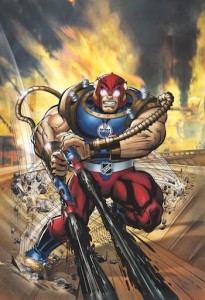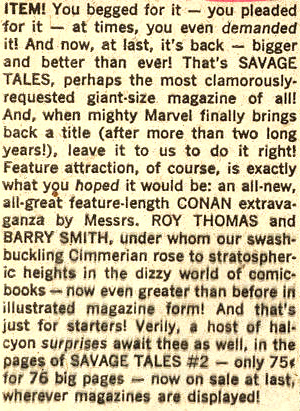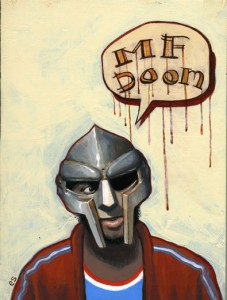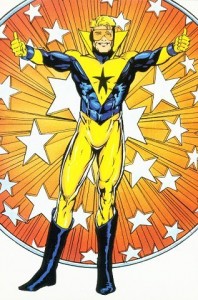The NHL’s Guardian Project is a misstep
The National Hockey League’s All-Star Weekend has come and gone, generally creating a positive buzz for professional hockey in North America.
The All-Star Fantasy Draft, where captains Eric Staal and Nicklas Lidstrom selected their superstar teams schoolyard style, was a huge success, averaging 600,000 viewers in the United States.
Unfortunately, the lingering product from the gala event in Raleigh N.C. is the Guardian Project, the NHL’s misguided attempt at drawing in today’s youth.
The Guardian Project is a marketing campaign where legendary comic book creator Stan Lee designs super heroes based off the names of all 30 NHL franchises.
Sounds good in theory, but in practice the idea plays out like a super villain’s hare-brained scheme. Stan Lee + comic books + hockey teams + ???? = world domination.
In other words, it’s not very well thought out.
The NHL Guardians are problematic from their very conception. First, Stan Lee simply doesn’t have as much cultural cache as he once did. After all, he hasn’t had a monthly title since Ravage 2009 in the early 1990s. You know, when the Guardian Project’s target demographic was still years away from being born.
Second, the characters themselves are lame. Witness Chris Sims of ComicsAlliance epic takedown: The Ten Most Insane Characters From Stan Lee's 'NHL Guardians'.
Many of the characters seem to be based on a brief skimming of each franchise’s Wikipedia page. Important details like the military heritage of the Chicago Blackhawks and Toronto Maple Leafs aren’t touched on at all.
Most importantly, the NHL’s marketing department is once again playing away from the game’s strengths.
Hockey is one of North America’s oldest sports, with the NHL’s Original Six predating any National Basketball Association franchise, only a handful of National Football League teams and most Major League Baseball clubs.
It’s a disgrace that the Montreal Canadiens, a franchise that is over 100 years old and a cornerstone of Quebecois society, is being represented by the likes of this:
But campaigns like Project Guardians relies on trendy thinking that makes the NHL seem newer than the Arena Football League or other shaky niche sports.
Seriously – the Tampa Bay Storm of the Arena Football League predate the Tampa Bay Lightning by five years. The Charlotte Rage were created and folded before the Carolina Hurricanes moved from Hartford, Conn. The list goes on and on.
Commissioner Gary Bettman and the rest of the powers that be at the NHL have to learn that if they really want to make inroads in the Sun Belt, they need to educate and inform their new fanbase about the rich history and tradition of the game, not disregard it.
Otherwise, the NHL comes off as just the latest in a long line of failed sporting enterprises.
That’s why innovations like the All-Star Fantasy Draft and the Winter Classic have been so successful: because they are reminiscent of the history and tradition of hockey.
It’s also why the NHL’s Guardians Project was a dreadful misfire: it glosses over one of the most appealing aspects of hockey.
The Box of Punishment Lives On
As many long-time readers of this blog know, I am a fan of comic books.
I’m particularly drawn to more realistic characters like the Question, Batman and especially the Punisher. I appreciate the fact that it’s just a small leap of faith to imagine a world where these guys really exist.
That gritty realism also increases the dramatic tension since, ultimately, the hero is mortal. Unlike Superman, Thor or Wonder Woman, the stakes are higher because, if not for the hero’s skills, he’d be dead.
Recently, I bought a little piece of comic book blogosphere history when I purchased the first 68 issues of the Punisher ongoing monthly series from Chris Sims of the Invincible Super-Blog, War Rocket Ajax and Comics Alliance fame.
These magazines – the entirety of Mike Baron’s run as writer on the title – were part of Chris’ infamous Box of Punishment when he read every book and comic starring Frank Castle he could get his hands on.
Now, I haven’t made my way through all these just yet, but something is striking about them.
Namely, these covers are fantastically bad. They’re not just unrealistic – diminishing the book’s charm – they’re laughably over the top.
Here are the five worst, in chronological order:
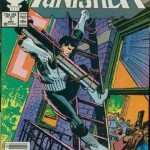 The Punisher #1 – A classic cover that grabs the readers’ attention as the Punisher breaks up a drug deal by levelling a bazooka at a criminal…. at point blank range.
The Punisher #1 – A classic cover that grabs the readers’ attention as the Punisher breaks up a drug deal by levelling a bazooka at a criminal…. at point blank range.
Never mind that missile launchers are probably too heavy to hold with just one arm, the real concern is that when Frank Castle pulls the trigger on that bad boy the kick will send him flying off his precarious perch on the fire escape.
Should the Punisher somehow manage to hold on, he’ll undoubtedly be killed by the explosion and ensuing shrapnel from the incinerated corpse of his victim and the building itself.
This is the tactical genius that strikes fear in the hearts of the Marvel Universe’s criminal brotherhood? Also, please note his all white boots and gloves, ideal for sneaking around in the dark alleys of New York City.
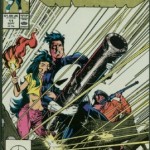 The Punisher #11 - For the next 10 issues the Punisher’s covers were limited to pretty standard fare. Indiscriminantly shooting off rounds at unseen targets… Cavalierly tossing grenades at the reader… You know, reasonable stuff.
The Punisher #11 - For the next 10 issues the Punisher’s covers were limited to pretty standard fare. Indiscriminantly shooting off rounds at unseen targets… Cavalierly tossing grenades at the reader… You know, reasonable stuff.
But then comes issue #11 (“Second Sight”) where our hero travels to Mexico to exercise his vengeance on human smugglers who left their cargo to die of dehydration in the desert wastelands of west Texas.
After drinking some mescal and going on a vision quest of sorts, Frank and the local brujo dispatch the people traffickers with a variety of weapons including a pitchfork and an antique cannon, apparently from the time of the Conquistadores.
You can see the cannon right there on the cover: the Punisher has ripped it off its moorings with his bare hands and is apparently going to fire it from his hip like an automatic rifle.
Again, it’s a physically impossible feat. The cannon, presumably made of cast iron, would easily weight a thousand pounds. When one of these cannons fires it rolls several feet and has to be pushed back into position by an entire crew of gunners. So, allowing that Frank was able to hold it up long enough for it to fire, he and his Mexican lady-friend would be sent flying by the recoil.
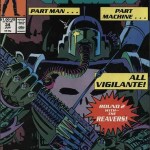 The Punisher #34 – After two years of reasonably sane covers, including growing a beard to infiltrate a gang of bikers, attacking a correspondence school for ninjas and flipping some punks in Las Vegas (for real) the Punisher had to tangle with his toughest foes yet – the Reavers, the mutant-hunting cyborgs who had (briefly) killed the X-Men.
The Punisher #34 – After two years of reasonably sane covers, including growing a beard to infiltrate a gang of bikers, attacking a correspondence school for ninjas and flipping some punks in Las Vegas (for real) the Punisher had to tangle with his toughest foes yet – the Reavers, the mutant-hunting cyborgs who had (briefly) killed the X-Men.
Their first battle didn’t go so well for Frank, resulting in him apparently becoming a cyborg himself. I particularly appreciate the fact that by the next issue he’s all better again. Because being turned into a cyborg is totally reversible. Just takes a quick overnight surgery and you’ll be flesh and blood again.
Also, for reasons beyond my understanding, all cyborgs and robots in the late 1980s and 1990s were depicted as being a deep green or purple. I really don’t remember metals turning that colour… ever… even in the Neon Nineties.
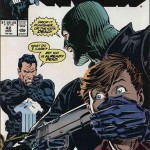 The Punisher #42 – Somewhere around issue #35 the editors at Marvel Comics decided to add some dark humour to the Punisher, edging the books toward self-parody or even camp. For example, puns and pop-culture references were littered throughout the six-part Jigsaw Puzzle storyline the preceded this issue.
The Punisher #42 – Somewhere around issue #35 the editors at Marvel Comics decided to add some dark humour to the Punisher, edging the books toward self-parody or even camp. For example, puns and pop-culture references were littered throughout the six-part Jigsaw Puzzle storyline the preceded this issue.
When the title returned to one-and-done stories the Punisher’s covers used that dark humour to try and grab the reader’s attention.
Issue #42 is a perfect example of this as Beachhead from G.I. Joe - okay, not really him, but it’s the same style of balaclava as the cynical Joe trainer - holds a gun to a hostage’s head and screams “DROP IT PUNISHER… OR THE KID’S DEAD!” to which Frank Castle, bereaved husband and father, replies “What do I care? My kid is already dead!”
There’s so much to enjoy here: the Punisher’s shockingly unconcerned approach to the safety of innocent victims of violent crime, the hostage’s panicked expression as they realize they’re totally screwed, the background completely devoid of any scenery. It’s all a rich tapestry.
But what I like best is that it’s firmly established in the Punisher canon that Frank Castle had two children. Apparently, in the heat of the moment he’s realized that he really only ever loved one of them.
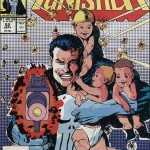 The Punisher #52 – Skipping over a few covers that see Castle strapped to the muzzle of a giant gun, standing on the roof of a cab before shooting the passenger and fighting neo-Nazis, we leave on a high note: “Maternity Ward”.
The Punisher #52 – Skipping over a few covers that see Castle strapped to the muzzle of a giant gun, standing on the roof of a cab before shooting the passenger and fighting neo-Nazis, we leave on a high note: “Maternity Ward”.
Excuse me, “Maternity War”. You see, a bullet hole has obscured the “d”.
Yes, the Punisher has gotten into a gunfight in the midst of a hospital’s maternity ward and he’s either trying to rescue four babies from the marauding baddies or maybe add on to his body armour.
I truly admire the editor’s dedication to the cover’s theme, from the wan smiley faces on either side of the issue’s title, to the bullet-riddled “Baby on Board” sign in the postmark box. Even the publisher’s logo has a small child draped in the Punisher’s uniform and brandishing an Uzi. Such an impressive eye for detail!
It’s amazing how damn goofy these covers are, especially since this is supposed to be one of the most realistic characters in comics history.
Graphic Novel Review: Tom Strong by Alan Moore and Chris Sprouse
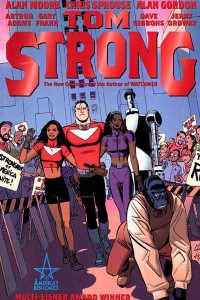 Every medium has its strange little quirks. Odd little rules of the form that have developed and that creators rarely deviate from.
Every medium has its strange little quirks. Odd little rules of the form that have developed and that creators rarely deviate from.
For example, it is rare for a movie to have a plot that unfolds in real time. Television shows are limited in length by half-hour increments, allowing, of course, for commercials. You may see a program that’s 15 minutes long, but never 45 minutes.
It’s theoretically possible to have a show be 20 minutes long or a movie that is in real time, but it’s rarely if ever done in practice.
Comic books are no different. They have their own rules and standards that creators are obliged to follow.
One of the most peculiar things about sequential art as a medium is that it is largely devoted to a single genre – superhero action/adventure.
There are certainly lots of comics that do not involve capes or tights. But the vast majority of the comics produced in this medium prominently feature superheroes.
It wasn’t always this way. In the aftermath of the Second World War, superhero titles began to disappear off the rack. Only Batman, Superman and Wonder Woman survived in any form. Titles like Captain America, Captain Marvel and Green Lantern were replaced by Westerns, Romances and especially horror books.
However, as the Silver Age dawned with Showcase #4 and Fantastic Four #1, superheroes came back in to vogue. DC and Marvel plunged into producing cape and tights stories almost whole hog. Even characters that were of other genres like Nick Fury, Jonah Hex, Mille the Model, Patsy Walker and the Two-Gun Kid were folded into their mainstream continuity.
Since then, the medium and the genre have been inexorably linked. Sure, there are still some comics that do not feature superheroes, but they are few and far between.
It would be like if CBS and NBC’s programming was almost entirely police procedural dramas.
All this serves a lengthy preamble to talk about Alan Moore’s America’s Best Comics, an attempt by the famed author to break free from the superhero genre. He introduced books like Top 10, Promethea and Greyshirt that were departures from the usual comic book fare.
The most prominent work in the ABC line was Tom Strong, an analog of Doc Savage, Tarzan, Tom Swift and other pulp-styled heroes of the early 20th century.
Although still definitely an action-adventure story, Tom Strong is not a crime fighter or vigilante of any sort. His primary interest is science and education. He’s constantly inventing Swiftian devices that, predictably, become useful in his latest adventure. He is a utopianist devoted to improving his world.
Of course, Strong is often beset by villains who want to destroy his hometown of Millennium City or kill him to avenge an earlier defeat. Enemies like Nazi air pirate Ingrid Weiss, technological plague the Modular Man and Strong’s arch-nemesis Paul Saveen plague the hero and his family.
They’re all fun, off-beat characters that can make you laugh while remaining threatening to the safety of Tom Strong and his extended family.
As always, Moore does a fantastic job of developing characters quickly and creating entertaining traps for Strong to unravel, all while maintaining the traditional sense of fun inherent in all pulp fiction.

Chris Sprouse's incredible work on Tom Strong. Tom Strong is conceived as Pneuman the Pneumatic Man watches on.
Chris Sprouse’s artwork shines. It’s crisp, clean and expressive, while being remarkably detailed where required. He’s a master illustrator who can communicate emotions to his readers in a single, textless panel. It’s some of the best artwork I’ve ever seen in a comic.
Sprouse isn’t the only penciler on this series though. Other acclaimed artists like Arthur Adams, Gary Frank, Dave Gibbons and Jerry Ordway lend a hand. Their inclusion in the project was done in a very clever way – they draw all the flashback scenes. Because these looks into Tom Strong’s past are presented as older issues of the series, the different styles aren’t jarring and, if anything, add to the whole piece.
I would recommend Alan Moore’s Tom Strong to anyone who enjoys comics, but especially to those who want a break from the more mainstream and mundane superhero books that clutter shelves at your local shop. He remains one of the few creators in the medium that can shed the cloak of superheroes.
Free Comic Book Day 2010
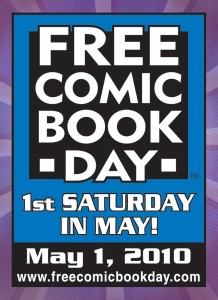 As comic book fans across North America know, last Saturday was the annual Free Comic Book Day.
As comic book fans across North America know, last Saturday was the annual Free Comic Book Day.
FCBD is an ingenious promotion that publishers and stores across the continent have developed to encourage new readers to try out comics and graphic novels.
It’s a simple concept: on the first Saturday in May most major comic book publishers release free copies of comics which the stores hand out to any and all customers. The idea is to get new patrons into the stores and to introduce older fans to new titles or creators.
Although I’m a big-time comic book nerd, this was my first experience with FCBD. I went to Paradise Comics, my Local Comic Store, and dragged my girlfriend Katy along.
Between the two of us we picked up six comics:
Boom! Studios – Irredeemable/Incorruptible double-sided: This was actually the last comic I picked from the spread. It just so happened that the Incorruptible cover was the one facing up on the table, and that’s what drew me in. Of course, Mark Waid’s story is great and as these are reprints of both series’ first issues, this was a perfect jump-on for new readers.
I’d read Irredeemable before, and think its concept of superhero-turned-ultimate-villain is fine. Certainly, Waid does an excellent job of building a sense of dread and terror as Superman-analog the Plutonian rampages around the world.
The only problem is that it’s been done before. Watchmen, the Dark Knight Returns, Rising Stars and the Squadron Supreme, amongst others, have broached these themes before. It’s not that Waid does it better or worse than these other titles, it’s just well-tred territory.
Incorruptible, however, is brilliant. It chronicles the reaction of supervillain Max Damage to the Plutonian’s berserker rage and his decision to prepare to fight the hero. I am hooked. I want more, and that’s what Free Comic Book Day is all about.
IDW – G.I. Joe #155 ½: I’m definitely a fan of G.I. Joe but this comic did nothing for me. The Joes themselves are only mentioned in one panel of the comic. Although there’s a great deal of action, the plot relies heavily on past storylines from earlier G.I. Joe comics.
I can see that some people might be intrigued by Cobra Commander’s scheme to take over the United States, but it seems like a very continuity-heavy book that could turn off new fans drawn in by the recent live-action movie.
Maerkle Press – Love and Capes #13: I’d heard good things about this comic from the Invincible Super-Blog and an interview with creator Thom Zahler on an episode of the War Rocket Ajax podcast.
As usual, Chris Sims and Eugene Ahn didn’t lead me astray. It was a fun, light-hearted read about the newly-married Crusader and his wife Abby as they adjust to their new life together.
The humorous vignettes of what it’d be like to be a married superhero were good for some laughs and Zahler’s artwork is clean and expressive.
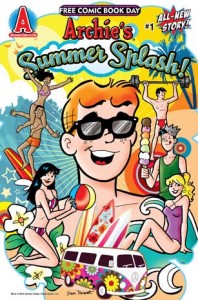 Archie Comics - Archie’s Summer Splash #1: Written and illustrated by Dan Parent, this comic is exactly what you’d expect from the good folks at Archie. It’s a fun, one-and-done book centred around a minor social conflict between average American teenagers.
Archie Comics - Archie’s Summer Splash #1: Written and illustrated by Dan Parent, this comic is exactly what you’d expect from the good folks at Archie. It’s a fun, one-and-done book centred around a minor social conflict between average American teenagers.
I appreciate that Archie Comics put out a brand new story for FCBD and one that can be easily understood by any new reader. I’m just sorry that it doesn’t really focus on the main four Riverdalians (Archie, Jughead, Betty and Veronica). Sure, they’re there, but they could have been anyone.
That said, that’s my only complaint. Parent strikes again, doing a solid job of writing and illustrating this story.
Marvel Comics - Iron Man/Nova: Along with the Incorruptible half of Boom’s efforts, this was the best comic I read on Saturday.
Specifically labelled as “Great for all ages”, this book is fun and easy for any fan to understand. Craig Rousseau’s artwork is very detailed while remaining light and easy on the eyes. Writer Paul Tobin squeezes a lot of exposition into the dialogue between Nova, Iron Man and Kate McMillan but manages to keep the plot moving.
I like the choice of heroes as well. Obviously, Iron Man’s inclusion serves as a tie-in to Iron Man 2 which comes out in just one week. Nova is an odder choice as he’s got a lower profile than most characters, but since he is going to be a member of the new Secret Avengers book coming out this month his inclusion also makes sense. Nova is also more accessible for younger readers, since he’s a college student, an everyman in the vein of Spider-Man.
Also, it features monkeys and apes. Who doesn’t love simians?
Marvel Comics - Iron Man/Thor: Inversely, this is the worst comic I picked up on Saturday.
In theory, it should’ve been great. As mentioned above, Iron Man has starred in a wildly popular movie with another one coming out in a few days. Thor’s movie is in production and is a cornerstone of the Marvel Universe. There’s a lot of buzz surrounding the characters.
Matt Fraction is one of the hottest scribes in the industry right now, writing the monthly Iron Man and Thor titles. Penciler John Romita Jr. is one of the best comic book artists ever, and a mainstay of Marvel comics. Again, you’d think a creative team like that would be a slam dunk.
Unfortunately, this story is confusing as all hell. Both characters are kind of jerks, not just to the villains but to each other as well. It’s hard to place when in continuity this happens and it ends on a puzzling note with Thor flying over a wrecked supertanker in the green fields surrounding Ayer’s Rock in Australia and Iron Man standing on the moon before a bunch of wreckage that includes a sign for Stark technology.
Not the kind of gateway to two monthly titles that Marvel was probably hoping for and a disappointment to fans familiar with the characters or creators of this issue.
Follow Friday – the Twitter Bullpen
Growing up I was fortunate to have access to my dad’s wonderful Silver Age collection of comics. Also, since I grew up in the 90s, I could pick up relatively cheap back issues from the medium’s second golden age, the 1980s.
As a result I’ve been exposed to some of the real magic of Marvel Comics. Obviously, the stories and artwork is the major draw of their library, but one of the really attractive things about these eras was the infamous Bullpen Bulletins.
In short, the Bulletins were a newsletter inserted into all of Marvel’s monthly titles that talked about the comings and goings of their roster of writers, artists and editors.
Really, it was an invention of editor-in-chief Stan Lee to promote new titles and new talent. The Bullpen Bulletins were always over-the-top and Barnum-esque but it was also entertaining and made you feel like you were right there with your favourite creators.
Marvel discontinued the feature in 2001, and I can’t say that I blame them. After all, the Bullpen itself had been dispersed by the advent of digital technology allowing a lot of freelancers to work from home.
Further, today’s creators are able to float between DC Comics, Marvel, Image, Dark Horse and other publishers, meaning that the esprit de corps that was at the heart of the Bulletins was seemingly at an end.
Twitter has rekindled that sense of camaraderie and taken it to the next level. Instead of getting to read monthly highlights of Bullpen sessions, comic book fans can now follow the jabs, jokes and work of all their favourite creators on a minute-by-minute basis.
The queen of the comics Twitter-verse has to be Gail Simone, the writer of Secret Six and Birds of Prey. She is one of the most active Tweeters out there. One of her regular “features” is to antagonize her fellow comic creators and hilarity often ensues.
Warren Ellis is the author of many books and magazine articles, but is also known for his comics work including Transmetropolitan, Nextwave, Planetary and Hellblazer. His Tweets are jovially cantankerous as he playfully abuses his followers.
A more light-hearted creator is Dan Slott, the current scribe of Spider-Man. He also penned a tragically short-lived run on the Mighty Avengers which recently concluded. He often discusses his writing process and things he loves about his job. It’s a fun read.
One of my favourite comic book writers is Kurt Busiek, the author of the brilliant creator-owned Astro City. He’s done a ton of other work for just about every comic publisher you can name. If you’ve never read it, his run on the Avengers with master illustrator George Perez is some of the best comics work ever.
Finally, there’s the duo of Ed Brubaker and Matt Fraction, who have turned the Marvel universe on its ear in the past few years.
Brubaker just finished an incredibly strong run on Daredevil and continues to pen Captain America. Fraction is the current mind behind the X-Men, Thor and the Invincible Iron Man. The two collaborated on the Immortal Iron Fist, a joy to read that ended too soon.
There are myriad other creators on Twitter, but these are a few of my preferred feeds. It’s fun and exciting to see the Bullpen continue on, at least in spirit, in the digital age. If you’re a fan of comics, you should try looking up your favourite writer and artist and get to know them just as Stan Lee once envisioned.
Why I love rap music
I’m not a particularly musical person – I was kicked out of the school band in grade 7 because I was so inept at playing the trumpet – but I love listening to music.
In fact, whenever I write I have my iTunes running on random shuffle. Although I’ve got an eclectic collection of songs, the vast majority of it is hip-hop.
The reason is simple - even though I’m a middle class white guy, rap music speaks to me more than any other genre. Sure, I like rock, country or even some classical music but for me, nothing compares to urban music.
I’ll be the first to admit I come from a very different world than most rappers. Aside from Drake – who grew up around the corner from my apartment – I can’t honestly say that I identify with the hard, impoverished world of many rappers. The violent and often criminal reality of a rapper like Snoop Dogg or Dr. Dre is something I’ve never experienced and hope I’ll never have to.
However, I can identify with Dr. Dre’s concerns about aging and re-establishing his personal identity as he does in the classic album Chronic: 2001. I can also empathize with Jay-Z on his track Young Forever from the Blueprint III. The subject matter may be foreign, but the themes are universal.
Unlike a lot of media, rap often conveys narratives with humour and playfulness that belies the seriousness of the content. As the Atlantic’s Ta-Nehisi Coates recently pointed out, a talented MC like Ghostface Killah can make you laugh while describing selling drugs in a school zone.
I think a fair comparison would be enjoying classic literature. I will never be in the dense colonial jungles like Kurtz in Heart of Darkness and I will never be a drug dealer like the Notorious B.I.G. in “Juicy”, but I can be moved by both.
However, hip-hop makes itself more accessible then a lot of other media by being the most culturally aware of all musical genres.
Lyrics refer to historical events, other musicians, television, comic books or movies. You just can’t find a line like Everlast’s “Because I can feel it in the air tonight/but yo I’m not Phil Collins/I’m more like Henry Rollins” in other kinds of media. At least, not often.
Whether it’s the Beastie Boys name-checking Star Trek, the various members of the Wu Tang Clan creating “secret identities” based off of super-heroes from Marvel Comics or MF Doom basing his entire persona of the villain of the same name, rappers locate themselves in a cultural context that any listener can easily identify.
It goes well beyond lyrical styling - the beat itself is often a sample from another song or a television show. Busta Rhymes using the theme from Knight Rider or DMX and Onyx using the intro to Welcome Back Kotter for “Slam Harder”.
The music itself is a clever nod to the urban environment that it’s created in.
Floating snippets of familiar hooks and beats and sampled choruses are reminiscent of music floating out of neighbourhood windows as you walk down the street. Thumping bass simulates the clacking of subway cars riding on aging tracks. Changing lyrical flow or rotating MCs is a lot like catching parts of a conversations as you pass people on the sidewalk.
It’s impossible to listen to Grand Master Flash and the Furious Five’s “the Message” and not recognize the frustrations of living in a city. The same can be said of Kurtis Blow and Run DMC’s collaboration for “8 Million Stories”.
This culturally-awareness is the great strength of rap. It makes it more relatable and current. These references helps hip-hop bridge significant divides like politics, gender, religion and, of course, race. Hip-hop inspires and entertains me like no other kind of music.
The Return of the Superhero Originality Game
 A recent strip from Let’s Be Friends Again by Chris Haley and Curt Franklin perfectly sums up how I feel about Marvel and DC Comics. Basically, I think that the two major purveyors of sequential art are in a creative malaise largely of their own making.
A recent strip from Let’s Be Friends Again by Chris Haley and Curt Franklin perfectly sums up how I feel about Marvel and DC Comics. Basically, I think that the two major purveyors of sequential art are in a creative malaise largely of their own making.
A few weeks ago, I wrote about an exercise - the Superhero Originality Game – that highlights that stagnation. The rules are explained at length in my previous post but, in short, the idea is to try and think of completely original characters that were created in the past thirty years that could (or have) carried their own monthly titles for Marvel or DC Comics.
I had gotten the ball rolling with a list of 10 characters who met the criteria:
1.Booster Gold
2.The Sentry
3.Wild Dog
4.Speedball
5.Elektra
6.Venom (Eddie Brock or Angelo Fortunato but not Mac Gargan)
7.Amanda Waller
8.Terror Inc.
9.Deathstroke
10.Deadpool
I had invited my readers to try and add to the list, and they came up with an additional 14 characters:
11. Rage
12. Night Thrasher (Dwayne Taylor, not his brother Donyell Taylor, aka Bandit)
13. Amadeus Cho
14. War Machine
15. Zauriel
16. Shatterstar
17. Magog
18. Beta Ray Bill
19. Lobo
20. Cloak and Dagger *
21. Cyborg
22. Raven
23. Starfire
24. Silver Sable
The point of the game was to try and highlight the fact that, to a large extent, the Big Two comic book publishers have produced less than one new marketable character per year. It’s not just that they’re no longer creating new series, there aren’t many original characters being created, period.
Instead, comic book fans are being treated to Spider-Man fighting the Vulture. Again. Or another Teen Titan dying. Rehashing and re-telling seems to be the name of the game.
It’s a disappointing trend.
Imagine if two major television networks like ABC and NBC only introduced a total of 24 new television shows over the course of three decades? Advertising revenue would quickly dry up and they’d be out of business. The stagnation would have killed them.
One thing I’ll say about these 24 characters is that they are an impressively diverse group. Six and a half (Cloak being one half of an entry)are visible minorities. Five and a half are women. One is a space horse.
They also have diverse origins and motivations, with at least 12 of them being spanning from “morally ambiguous” to “ethically reprehensible”. Whether they are mercenaries, assassins, exceptionally greedy or intelligence operatives for the government, they’re a surprisingly complex group of protagonists.
Unfortunately, only five are currently starring in a book, either in a solo title (Booster Gold, War Machine, Amadeus Cho, Deadpool) or a team book (the Sentry). Even in that group, War Machine’s book is being cancelled and there are rumours that the Sentry is going to be killed as part of the Siege.
This lack of creativity is particularly stunning when you think of all the characters that Stan Lee and Jack Kirby created for both companies between 1960 and 1975. Together and separately they produced dozens of enduring characters. Why can’t their success be replicated even a little?
I think the big problem is that Marvel and DC Comics are incredibly risk averse and reluctant to try anything new. Instead, they’d rather play it safe and go back to the well time and time again, appeasing a hardcore group of fans rather than reach out and try out new characters that could appeal to a broader base of readers.
It’s a crying shame that in the long run will hurt the comics business.
*I looked into Cloak and Dagger and it’s kind of up in the air as to whether or not they’re mutants. They’ve been described as having powers that were activated by the experiments they were subjected to. To keep it simple, we’ll just assume that they’re not mutants.
An ode to Booster Gold
It’s funny how everyone has a guilty pleasure - a band, movie or book that we love but was hardly a critical or commercial success. Comic book fans are no different. They always have at least a couple of characters that they hold dear to their heart.
I know that I’ve got a few. There’s one name that’s always at top of mind for me though: Booster Gold.
Never heard of him? That’s cool, most people haven’t. Indeed, it’s a running joke on an episode of Justice League Unlimited that everyone thinks that he’s Green Lantern and they’re disappointed when they find out that it’s Booster Gold.
Booster Gold is Michael Jon Carter, a collegiate football star from the far-flung future of the 25th century. He started placing bets on his own games and then threw them for profit. Disgraced, he became a night watchman at a museum that housed artefacts from the so-called Age of Heroes – our modern heroes like Superman and Batman.
With the help of a floating security robot named Skeets, Booster stole equipment and weapons from the displays, and used Rip Hunter’s time machine to travel to the 20th century. When he arrived in the 1980s he used his limited knowledge of historical events to position himself in the right place at the right time and become a superhero brand that would save lives as well as turn a healthy profit.
With Skeets acting as a roving encyclopedia, Booster blunders from heroic episode to heroic episode, often doing more harm than good while trying to create a public image that he can gain from financially. Recently (and somewhat improbably) he's become the guardian of the time stream, trying to maintain order and balance in the universe.
There are two things that appeal to me about Booster: his origin and how well he reflects the zeitgeist of the 1980s.
I think that the best fictional characters, superheroes and otherwise, have origins that explain their motivation for the rest of their existence. Sticking to comic books, some Batman, Spider-Man and the Punisher are popular because they are driven by a combination of guilt and anger over the death of their beloved family members.
All three of those creation stories make sense. To an extent, the reader can understand why these guys are dressing in spandex and putting their lives in danger. Their behaviour is clearly motivated by the tragedy in their origins.
Booster Gold’s driving force is simple: he’s greedy. He covers his uniform with corporate logos, puts money on the stock exchange before big bumps and is generally a glory hog. Or that time he married a sexagenarian for her money. It's not an altruistic reason for becoming a superhero, but it has an inherent logic. You can get what he’s about.
Just as Captain America was ideally suited to the surge of patriotism in the lead up to World War 2 or Marvel heroes like Iron Man and Nick Fury fit the Cold War era, Booster Gold’s 1986 debut was perfectly timed. He was just right for the greed is good, egotistical 80s. He developed as a character into the 1990s, just as corporate monopolies disguised as “synergy” and mass sponsorship became the norm in North America.
Booster Gold is often under-utilized but instantly appealing to anyone who grew up in the 1980s. He’s greedy, funny, a little bit cynical and surprisingly heroic. More than just about any other big name comic book character he fits into our contemporary worldview and, most importantly, he’s believable. The reader can understand why he does the things he does. He’s as real as a man from the future can be, and although he’s a guilty pleasure of mine, I rarely regret it.
Graphic Novel Review: Captain America: Winter Soldier vol. 1 & 2
One of my New Year’s resolutions was to read more comic books and graphic novels. Hardly a self-improvement project, I know, but I want to get down with my nerd self.
My first graphic novel of 2010 is Captain America: Winter Soldier vol. 2, allowing me to complete the first story arc of Ed Brubaker’s popular run on one of Marvel Comics’ most recognizable characters.
I’ve never been much of a Captain America fan. I prefer grittier characters like Batman or the Punisher, so his squeaky clean image never appealed to me. And since I’m Canadian, all the patriotic beats were lost on me.
But Brubaker’s Winter Soldier storyline sucked me in. I’d heard that the new Captain America series was going to be bringing back Bucky, a character who had been dead since the end of World War II, and it hooked me.
This was a Big Deal to comic fans. Bucky had been Cap’s 16-year-old sidekick during the war, but was tragically killed when a missile he was trying to disarm exploded in mid-flight. The same incident dropped Cap into the frigid North Sea, freezing him until the 1960s.
The death of Bucky had always been cited as the reason why Marvel’s superheroes don’t have teenaged sidekicks - unlike their DC counterparts - and it added a sense of realism to the company’s mythos.
For Brubaker to be retconning a fundamental element of Marvel Comics seemed like heresy, albeit an intriguing act of rebellion.
Captain America: Winter Soldier Book One and Two brings together issues 1-14 of the fifth monthly series to star Steve Rogers. They revolve around a terrorist attack that was apparently perpetrated by a mythical Cold Warrior known as the Winter Soldier who may actually be Cap’s former partner Bucky.
Resurrection storylines have become commonplace in comics, a constant recycling of characters who had been killed for dramatic effect, only to return. It’s a trend that is holding back a medium that I love. But Brubaker handles the return of the long-dead hero with a deft hand that provides not just a plausible explanation for his survival, but an engrossing story.
Interspersed with action, character moments and plot developments, Winter Soldier begins with Captain America becoming angry and frustrated with the inability of the United States government to attack countries that sponsor terrorism. The detonation of a Weapon of Mass Destruction in Philadelphia leaves a trail that leads to former Soviet general Aleksander Lukin, and his shadowy operative the Winter Soldier.
Even the name Winter Soldier is clever work by Brubaker. It’s a reference to the loyal American revolutionaries who stuck with George Washington over the harrowing winter in Valley Forge, but also to the Winter Soldier Investigation, a Viet Nam era examination of atrocities and war crimes committed by the United States Armed Forces.
Brubaker seamlessly connects the Second World War, the Cold War, modern terrorism and Captain America’s complex continuity. It’s not just that he brings in plot points from every era of Cap’s 70 years of existence, but the pacing and style of the book draws heavily on these aspects of the character’s history.
To me, a classic Captain America story has him and a partner rushing off into danger to stop a catastrophe from befalling the United States or the world. Winter Soldier is no different, with Cap rushing to stop Kronas Corporation with the Falcon riding shotgun.
Steve Epting’s art work in this series is fantastic. I can’t think of a current comics creator who makes better use of inking and colouring techniques. His characters are expressive and natural in conversation, and dynamic and fun during action scenes.
In particular, the way he draws the acrobatic Captain America jumping, rolling and bouncing in fight scenes is thrilling.
Winter Soldier breaks an old comic fan saying: “No one stays dead, except Bucky and Uncle Ben.” The phrase refers to the fact that Peter Parker’s uncle and Captain America’s sidekick must stay dead because their loss is what, in part, forms the hero we know today.
I never thought I’d see the day where that axiom was successfully reversed, but the Winter Soldier saga does it.
The return of James “Bucky” Buchanan Barnes was enough to catch my interest and buy the first volume of Captain America: Winter Soldier, and the gripping story has lead me to the rest of the series. Brubaker’s writing isn’t some gimmick. It’s some of the best mainstream superhero comic work I’ve ever read.
